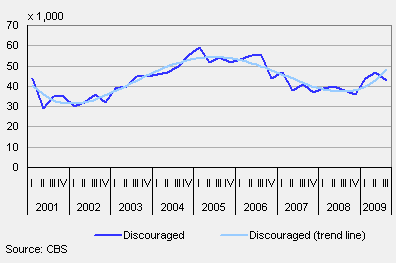Lower educated people more pessimistic about finding jobs

In the third quarter of 2009, more than 40 thousand people, i.e. 5 thousand more than one year previously, would like to have paid jobs, but were not actively seeking, because they thought their chances on the labour market were slim. The lower educated strata in particular are inactive.
Over 800 thousand people seeking paid jobs
In the third quarter of this year, more than 800 thousand people not included in the employed labour force would like to have paid jobs for twelve hours or more a week. This group is also referred to as the unused labour force.
The unused labour force includes nearly 400 thousand unemployed, i.e. people actively seeking jobs and instantly available for the labour market. In addition, over 150 thousand people are not immediately available, e.g. because they are in the process of graduating.
The remainder of the unused labour force are people who are available for the labour market, but are not actively looking for work. This group includes over 40 thousand so-called disillusioned individuals. They were not actively on the labour market, because they were very pessimistic about their chances.
Persons prepared to work at least twelve hours a week, third quarter of 2009

More people lose heart in times of economic hardship
The number of disillusioned people grew by more than 13 percent in the third quarter relative to one year previously. This group tends to expand in times of economic hardship, like the period 2003-2005. People who are disillusioned indicate that they think their chances on the labour market are slim. When the economy picks up, they might start looking for work again.
Number of disillusioned persons in the unused labour force

Lower educated in particular have little hope of finding jobs
More women than men belong to the group of people who think their chances on the labour market are poor. Between the third quarters of 2008 and 2009, both groups increased by approximately the same number. The most substantial increase is recorded in the category of lower educated. Nearly six in ten in the group of disillusioned are lower educated, as against four in ten one year ago.
Disillusioned by various characteristics

Lian Kösters and Kasper Leufkens